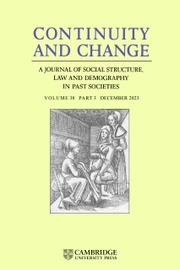As I write this review, the world is looking with increasing anxiety to the news from China about the recently discovered coronavirus (2019-nCoV). All of us wonder whether the most populous country in the world will be able to cope with the rapidly spreading epidemic, what could be the most effective measures that our highly interconnected societies can undertake to limit the diffusion of the virus, and how the world should best prepare to face an eventual pandemic. Moreover, western countries also face increasing episodes of racism and intolerance against East Asian communities, ignorantly claiming their hygiene and social habits are incompatible with those in the West. In this context, John Henderson's timely book can really speak to our minds and hearts. It provides an amazing micro-historical account of the social and cultural aspects of the 1630 plague in Florence, and it will surprise any reader (more or less expert) how past societies, when dealing with epidemics, have faced challenges, problems and decisions similar to the ones that we are facing now.
The 1629–1630 plague hit most of continental Europe, and Henderson provides us with a very detailed description of how, in the summer of 1630, it struck the city of Florence, the capital of the Grand Duchy of Tuscany. The first chapter is a historiographical introduction to the main themes that form the core of his analysis: plague and healthcare. And, in particular, the chapter provides an account of how the recurrent plagues in late medieval and early modern Italy (and Europe more widely) progressively changed medical knowledge of the epidemics, even if only to a limited degree, and to a greater extent increased the awareness that coordinated and publicly provided policies were needed to contain the consequences of the diseases.
With this overview in mind, the reader is then brought to the core of the book, which is divided into two sections. The first presents the historical development of the plague in Florence, the measures undertaken to prevent it from spreading, and those implemented for curing the city once the disease had arrived. The second deals with three relevant themes associated with the consequences of those measures: religious practices, health and physical isolation of the sick, and the legal issues that those measures implied. Throughout the book, the author provides a rich set of data and narratives directly drawn from historical records and always has in mind one fundamental question: how did the fear of epidemics interact with the social, economic and cultural structure of the city?
Each chapter of the first section represents a step of the journey of the plague, following its progression from Northern Italy to the very heart of the Florentine civic and social body, and often adopting the perspective of the increasingly anxious city administration. Chapter 2 provides a description of how the plague descended from northern Italian regions, and the measures that the Florentine administration set up (in vain) to prevent the epidemics from breaking out in the city. Then, chapter 3 analyses how contemporary medical knowledge drove public policies towards the cure of those at the bottom of the society, the individuals whose habits were thought to create the conditions most favourable to the diffusion of the plague. Chapter 4 provides a complete account of the public policies implemented by the Grand Duchy, the measures to isolate and cure the sick (and poor), and chapter 5 deals with the actual impact of those policies, such as quarantine imposed at home or in the ad hoc hospitals (the Lazaretti). Overall, this first section combines an overarching narrative with quantitative descriptive analysis; presenting the image of a city that tried to resist the arrival of the plague, but when it realised that isolation from outside was unsuccessful, put in place an impressive set of public measures to isolate the city from the internal threat of those members of the community thought to be the ones responsible for the plague's diffusion.
The second section analyses three broader themes relating to the history of the 1630 plague in Florence. In chapter 6, Henderson deals with how the plague changed the religious attitude of the population, emphasising how devotion was seen to complement medicine in the attempts to limit the spread of epidemics. Chapter 7, instead, focuses on the functioning and the effectiveness of the Lazaretti in the cure of the disease. Very often people from the lower strata of the society were obliged to leave their house and move into these hospitals, sometimes with some or all of their family members. Those who did not go remained quarantined at home, forced to limit their social and economic interactions. Of course, not all the citizens welcomed these provisions, especially when they hindered their economic and social conditions. In fact, chapter 8 shows the judicial controversies associated with the implementation of these public measures in time of plague and reveals the extent of the authorities’ benevolence towards the poor.
John Henderson's book certainly succeeds in its goals. This comprehensive picture of the city of Florence during the troubled summer of 1630 provides an essential foundation for any future work exploring the roots of public health care policies in times of epidemics, their implications for the economic conditions of those at the bottom of the social hierarchy, and their wider social and cultural consequences. But the book also achieves an additional and no less relevant goal. Indeed, it helps us to remember the historical roots and gradual evolution of civic and public measures, and the associated cultural attitudes that we hope will help us to cope with the challenges of the new epidemics, and our reawakened fears.



